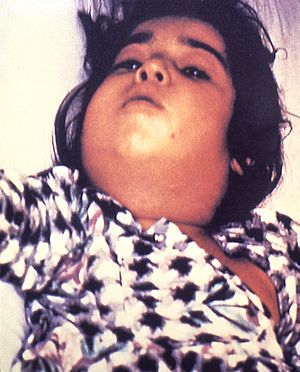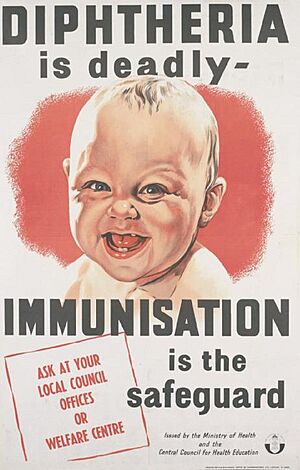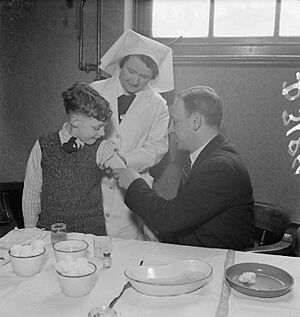Diphtheria facts for kids
Quick facts for kids Diphtheria |
|
|---|---|
| Symptoms | Sore throat, fever, barking cough |
| Complications | Heart problems, nerve damage, kidney problems |
| Usual onset | 2–5 days after being exposed |
| Causes | The bacteria Corynebacterium diphtheriae (spreads through coughing and sneezing) |
| Diagnostic method | Looking at the throat, lab test of a throat swab |
| Prevention | Diphtheria vaccine |
| Treatment | Antibiotics, a special tube to help breathing |
| Prognosis | 5–10% of cases can be fatal without proper treatment |
| Frequency | 4,500 (reported 2015) |
| Deaths | 2,100 (2015) |
Diphtheria is a serious infection caused by a type of bacteria called Corynebacterium diphtheriae. Many people who get infected don't show any signs, or only feel a little sick. However, the illness can become very severe.
Symptoms usually start two to five days after a person is exposed to the bacteria. It often begins with a sore throat and a fever. In serious cases, the bacteria create a thick, gray coating in the back of the throat. This coating can block the airway, making it hard to breathe and causing a barking cough. The neck can also swell up, which is sometimes called a "bull neck."
The bacteria that cause diphtheria spread from person to person, usually through tiny droplets in the air from a cough or sneeze. It can also spread by touching objects that an infected person has used.
Thankfully, there is a very effective diphtheria vaccine to prevent the disease. Because of widespread vaccination, diphtheria is now rare in many parts of the world. Treatment for diphtheria includes antibiotics and a special medicine called an antitoxin that fights the poison made by the bacteria.
Contents
Signs and Symptoms of Diphtheria
The symptoms of diphtheria usually appear a few days after infection. A person with diphtheria might have:
- A fever and chills
- A very sore throat that hurts when swallowing
- A barking cough
- Feeling tired and weak
- Swollen glands in the neck
The most dangerous sign of diphtheria is a thick, gray coating that can form in the throat and nose. This coating, called a pseudomembrane, is made of dead tissue, bacteria, and other substances. It can stick to the throat and make it very difficult to breathe or swallow.
In some cases, the infection can affect the voice box, causing a hoarse voice and a loud, barking cough. This is known as diphtheritic croup and is a serious condition that requires immediate medical help.
How Diphtheria Spreads
Diphtheria is contagious and spreads from person to person. The most common way it spreads is through the air. When an infected person coughs or sneezes, they release tiny droplets containing the bacteria. If another person breathes in these droplets, they can become infected.
It can also spread through direct contact. For example, touching sores on the skin caused by diphtheria can pass the bacteria to someone else. Less commonly, a person might get sick by touching an object, like a toy or a tissue, that has the bacteria on it.
How the Bacteria Causes Sickness
The diphtheria bacteria cause harm by producing a powerful poison, known as a toxin. This toxin is what makes people so sick. Not all diphtheria bacteria make this toxin, but the ones that do are the most dangerous.
Once the toxin gets into the body, it travels through the bloodstream. It can damage important organs like the heart, kidneys, and nervous system. The toxin works by stopping the body's cells from making proteins, which are essential building blocks that cells need to survive and function properly. This cell damage leads to the serious complications of the disease.
How Doctors Diagnose Diphtheria
A doctor might suspect diphtheria if a person has a sore throat with the classic gray coating in the back of their mouth. The doctor will also ask about the person's symptoms and if they have been vaccinated.
To be certain, the doctor will use a cotton swab to take a small sample from the person's throat or from any skin sores. This sample is then sent to a laboratory. In the lab, scientists will try to grow the bacteria from the sample and test it to see if it is C. diphtheriae and if it produces the dangerous toxin.
Because diphtheria can be very serious, doctors often start treatment right away if they strongly suspect the disease, even before the lab results are back.
How to Prevent Diphtheria
The best way to protect yourself from diphtheria is to get vaccinated. The diphtheria vaccine is safe and very effective. It works by teaching your body's immune system how to fight off the diphtheria toxin.
The vaccine is usually given to babies and children as part of a combination shot, like the DPT vaccine. This shot protects against three diseases: diphtheria, tetanus, and pertussis (whooping cough). To stay protected, people need several doses of the vaccine during childhood and then booster shots about every 10 years throughout their life.
Thanks to vaccination programs, diphtheria is now very rare in many countries. However, it can reappear if people stop getting vaccinated.
How Diphtheria is Treated
If someone gets diphtheria, they need to be treated in a hospital right away. There are two main parts to the treatment:
- Antitoxin: This is a special medicine that neutralizes the diphtheria toxin circulating in the blood. It helps prevent the poison from causing more damage to the body. It is important to give the antitoxin as soon as possible.
- Antibiotics: Doctors also give antibiotics, like penicillin or erythromycin. These medicines kill the diphtheria bacteria in the body. This stops the bacteria from producing more toxin and helps the person get better.
In severe cases where the gray coating in the throat blocks breathing, doctors may need to insert a tube to help the person breathe. This is called intubation or a tracheotomy.
History of Diphtheria
Diphtheria has been making people sick for centuries. In the past, it was a very common and feared childhood disease that caused large epidemics and many deaths.
- In 1826, a French doctor named Pierre Bretonneau gave the disease its modern name, diphthérite, from a Greek word meaning "leather," because of the tough, leathery coating that forms in the throat.
- In 1883, the bacterium that causes diphtheria was identified by Edwin Klebs. A year later, Friedrich Loeffler was the first to grow the bacteria in a lab and showed that it produced a toxin.
- In the 1890s, a major breakthrough happened. Scientists Emil von Behring and Shibasaburō Kitasato discovered that they could create an antitoxin from the blood of animals that had recovered from diphtheria. This antitoxin could be used to treat sick people. For this work, von Behring won the first-ever Nobel Prize in Medicine in 1901.
- One of the most famous diphtheria outbreaks was in 1925 in Nome, Alaska. The town was cut off by a blizzard and needed antitoxin urgently. A brave team of sled dog mushers raced through the storm to deliver the medicine, an event now known as the "Great Race of Mercy."
- In the 1920s, a vaccine called a toxoid was developed. By the 1940s, widespread vaccination programs began, and the number of diphtheria cases dropped dramatically.
Today, diphtheria is rare in countries with high vaccination rates, but it still occurs in parts of the world where children are not fully vaccinated.
See also
 In Spanish: Difteria para niños
In Spanish: Difteria para niños




